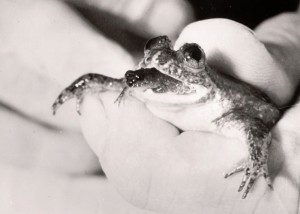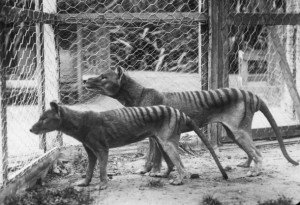“We are watching Lazarus arise from the dead, step by exciting step,” says the leader of the Lazarus Project team, Professor Mike Archer, of the University of New South Wales, in Sydney. This project is among the forefront of research today in trying to bring back to life creatures that have been extinct.
Though named after the biblical Lazarus of Bethany, the Lazarus Project has more to do with a species of frogs that brood their young ones in their stomach.
 The gastric-brooding frog is said to have gone extinct in 1983, due to unintended human intervention. Humans carry among them a chytrid fungus, that grow rampant among frogs. The frogs having no methods of evasion from a fungus that isn’t native, died out. It is one among many species like the Mastodon (large mammoth like creatures), the Sabertooth and the dodo, that are considered to be part of what’s called the modern extinction.
The gastric-brooding frog is said to have gone extinct in 1983, due to unintended human intervention. Humans carry among them a chytrid fungus, that grow rampant among frogs. The frogs having no methods of evasion from a fungus that isn’t native, died out. It is one among many species like the Mastodon (large mammoth like creatures), the Sabertooth and the dodo, that are considered to be part of what’s called the modern extinction.
The creatures that have been extinct since the last 10,000 years may still have enough information as DNA in their bodies for us to bring them back to life. This is because many of their remains are only now being thawed out of the permafrost of the Tundra or the snow peaks of the Andes. They’ve been protected from decay under the ice for all this time.
The technology required to bring back creatures from the dead is almost within our grasp. The ventures of de-extinction such as the Lazarus Project promise to repair the damage consequences of human civilization has done to the different ecosystems, but it also poses moral questions: should we be doing this? Is this “playing God”?
Mike Archer as well as many other scientists around the world argue that we have been interfering too much by pushing creatures beyond extinction with deforestation, overfishing, and non sustainable growth. “We should feel obliged to try and bringing back at least the creatures, whose extinction are we are directly responsible for.”
Creatures have been going extinct even before the dawn of man and isn’t this how natural selection works? Well, mass extinctions like that during the Cretaceous-Tertiary extinction that caused the dinosaur extinction have occurred five times before. An extinction period is classified as the periods in history where more number of creatures were going extinct as opposed to the number of new species coming up. What’s odd about the sixth extinction is that it’s the worst we’ve seen as a planet so far and the primary cause of that is human intervention. The last time there was an extinction phase, the ecosystem took 10 million years to stabilize again. Maybe we should try and prevent this instability from developing.
One of more interesting questions that scientists have faced is: Would we value the life of a species if we knew we were capable of bringing them back from beyond the veil of extinction? It was a refreshing insight to the problem at hand but, “It is far cheaper to conserve an already existing creature as opposed to bringing it back from extinction” said Stewart Brand, the author of the Whole Earth Catalog. Stewart Brand and his wife Ryan Phelan started an initiative called Revive and Restore, a project within The Long Now Foundation, with a mission to provide deep ecological enrichment through extinct species revival. Their hope is to be prepared. Even If an organism were to be brought back to life, enormous efforts would have to be taken to ensure life conditions would facilitate its continuous existence and also help to repopulate it further. if scientists were to bring an organism back.
This is a far more difficult a task than it appears to be. Sometimes ecosystems move on without the organism and upsetting the new ecosystem is what scientists are worried about the most. On the other hand some of these ecosystems are still currently at decline because of a missing creature.
A phenomenon called the “ Trophic Cascade” seems to govern over ecosystems, utilizing predators and other creatures at the top of the food chain as conservers. The Tasmanian Devil’s  decline would have been controlled had the Thylacine still been around. Tasmanian Devils have a communicable cancer that infected only it’s kind, like only seen otherwise in dogs. The Thylacine was the prime predator in Tasmania and fed constantly off on the Tasmanian Devil populations and also herbivores. The number of Tasmanian Devils that infected each other were kept in check, thus preventing the spread of the disease.
decline would have been controlled had the Thylacine still been around. Tasmanian Devils have a communicable cancer that infected only it’s kind, like only seen otherwise in dogs. The Thylacine was the prime predator in Tasmania and fed constantly off on the Tasmanian Devil populations and also herbivores. The number of Tasmanian Devils that infected each other were kept in check, thus preventing the spread of the disease.
Another incidence of “Trophic Cascade” can be seen in the example of how Yellowstone National Park decided to reintroduce wolves. Since the wolves were reintroduced, the deer and the elk have grown stronger as they run from the wolves. Grasses grow taller between migrations periods. Coyote numbers that were rampant here are also shrinking. This allows more birds like the Eagle and the Osprey more food to come back for. The endangered grizzly bears successfully steal wolf kills more often than not, thus having more food to feed their cubs.
Other times, habitats the resurrected species once lived in, does not exist. The Woolly Mammoth used to live in the Grasslands of Northern Eurasia. A cold desert, the Tundra, came about when there were no more mammoths around to till and fertilize the soil as packs grazed from region to region in the search for food within this area. Sergey Zimov, A Russian ecologist has been attempting with many other ecologists to recreate vegetation and fertile land in barren land like the Tundra. Zimov feels confident that mammoths could find a home much like they had before here at ‘Pleistocene Park’ in the Tundra. He says populating it with the mammoths would only accelerate that process.
Lets say we have the ability to bring a creature back from extinction. This would be baby clone of that extinct animal with no parents. That leaves no one to teach it where to find food, where to migrate to when the seasons change or about brooding. Luckily for us, most of these instincts are innate to an animal. However they do for a lot of reasons need a substitute teacher. Identifying creatures that would help teach animals would be another challenge entirely.
October 23 , 2012 marked the first closed session meet for scientists from all walks of biology came together at National Geographic DC to discuss, “De-extinction”. Stewart Brand in his report December, 2012 states the following as the
-
De-extinction is exciting, moving forward, and will eventually be tried.
-
It’s unlikely to happen very soon; we have time to do it right.
-
Research on the enabling technologies should be encouraged, coordinated, and funded.
-
Mutually beneficial linkages with other on-going endeavors (e.g., endangered species recovery, ecosystem restoration, and ex situ bio-banks) should be built.
-
Priority-setting for targets and outcomes is essential “before the train leaves the station” and our discussions here have advanced the thought process.
-
De-extinction is certain to be controversial for some.
-
To deal with anticipated obstacles there should be a pro-active lead-up to the day when de-extinction is attempted (i.e., building trust and knowledge):
-
well-planned dialogue with key “stakeholders” (private initiatives, interest groups, regulators, etc.)
-
regular, open conferences/symposia reporting on progress and providing a forum for serious dialogue
-
This level of strategic planning requires considerable organizational capacity.
The San Diego Zoo, in an initiative to create a Noah’s Arch of genomic data has started an initiative called “Genome 10K” for it’s Frozen Zoo. This aims at cataloging the full genome data of 10,000 vertebrate species—approximately one for every genus. What this gives us is a repository of genomic data that we can keep alive indefinitely. This repository also allows us to breakdown, analyze and use the genetic material to make up for all the patches of DNA that’s missing as a result of natural decay of cells for revival.
Alberto Fernández – Arias in an epic, brave attempt tried to bring the Pyrenean Ibex back in 2003, 13 years after extinction. Respiratory problems are common in cloning procedures and the Ibex developed an extra lung as dense as a liver. The Ibex died but a mere 10 mins after it was born. The theory was proven. Animals can be brought back, but the process isn’t entirely kink free yet.
The National Geographic team including DNA Direct and the Smithsonian are working on creating the passenger pigeon and after that the carolina parakeet. The genome for the passenger pigeon is being stitched together from the millions of remains of genetic material they have, filling up the spaces with that of a rock pigeon.
Michael Archer, leader of the ‘Lazarus Project’, who is working on the gastric brooding frog is stuck with a frog embryo but cannot seem to get the frog to the tadpole stage, yet. He is however optimistic about his research and talks about being able to bring it back very soon. After working on the amphibian, he hopes to move onto a marsupial mammal, the Thylacine.
Development in this research goes from lower in the evolutionary chain like amphibians to higher up, like mammals or/and from smaller creatures to eventually the ones that get more attention like the larger animals. The challenge of bringing back the mammoth is more than the gastro-breeding frog for many reasons from larger DNA genomes to longer Gestation periods.
Mammoths still do however stand a higher chance of being de-extincted thanks to the antifreeze protein in their blood which was among the first things that attracted scientists to mammoth studies.
The Russians, Koreans, Japanese and the Chinese have formed the North Eastern Genomic Alliance for a parallel in De-extinction studies having discovered within the melting perma-frost at the norther Tundra, more mammoth remains in the past 5 years than ever before. The quest for viable cells for cloning has begun. The deal was signed by Vasily Vasiliev, vice rector of North-Eastern Federal University of the Sakha Republic, and cloning pioneer Hwang Woo-Suk of South Korea’s Sooam Biotech Research Foundation
Sooam said it would launch research this year if the Russian university can ship the remains. The Beijing Genomics Institute will also take part in the project.
The South Korean foundation said it would transfer technology to the Russian university, which has already been involved in joint research with Japanese scientists to bring a mammoth back to life.
Within a few short years, we will have the capacity to reverse the damage we have done, giving back to the environment in more ways than we have been able to. It will still take a while before we see a herd of wooly mammoths walking the planet again. But wouldn’t it be nicer to show your children creatures you have always dreamt of seeing?
* * * * *
– Amit Fenn